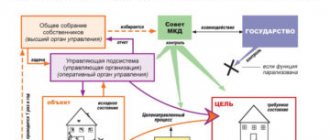A person or company lends money to another person or company. The lender is the one who lends, the borrower is the one who takes.
The lender wants to be sure that the debt will be repaid. What is the return guarantee? Pledge of the debtor's property. If the borrower does not repay the debt, the creditor will take the pledged property from the debtor, and the debt will be considered repaid. It is important to understand that a loan agreement and a collateral agreement are two different agreements.
The party to the contract who received the property as collateral is called the pledgee.
Articles 334-356 of the Civil Code are devoted to bail.
A note in the margin: a mortgage is a loan secured by real estate, and not a bank loan to buy an apartment, as many people think.
How is collateral used to protect property?
The fact is that in the event of bankruptcy of the borrower, the pledgee has more rights than those creditors who have nothing as collateral: the pledgee receives at least 70% of the amount that was received from the sale of the collateral during bankruptcy (clause 1 of Art. 138 of the bankruptcy law). Let's explain with an example.
Longtime friends Ivanov and Petrov entered into a loan agreement : Ivanov borrowed 10 million rubles from Petrov and gave Petrov his apartment as collateral.
Ivanov owed not only Petrov, but also Sidorov . Well, or I owe it to the tax inspectorate. Can't pay. Ivanov's bankruptcy procedure begins.
A financial manager sells a mortgaged apartment for 8 million rubles . 70% of this amount, that is, 5.6 million rubles, is received by Petrov as a mortgagee. The rest of the money from the sale - 2.4 million rubles - is credited to a special account and will go to other creditors.
As you can see, the deposit does not allow you to save the apartment itself. But he can protect part of its value. Of course, if you do everything right.
But businessmen don’t always get it right.
Real estate pledge agreement
Real estate pledge agreement No.
g.
"" g.
in the person acting on the basis, hereinafter referred to as the “
Pledgee
”, on the one hand, and in the person acting on the basis, hereinafter referred to as the “
Pledgor
”, on the other hand, hereinafter referred to as the “
Parties
”, have entered into this agreement, hereinafter "Agreement" as follows:
SUBJECT OF THE AGREEMENT
1.1. The subject of this Agreement is the transfer as collateral to the Pledgee of real estate owned by the Pledgor and the right to lease the corresponding land plot on which this property is located (hereinafter referred to as the “Subject of Pledge”).
1.2. The subject of the pledge is:
1.2.1. A real estate object owned by the Pledger - a building with an area of sq.m., at the address: , under the inventory number according to a copy of the explanation of the Territorial Bureau of Technical Inventory dated "" year, compiled as of "" year, which is an integral part of the Agreement (Appendix No. 1) . The boundaries of the building included in the Subject of Pledge are established in accordance with copies of floor plans of the Territorial Bureau of Technical Inventory dated “”, which are an integral part of this Agreement (Appendix No. 2).
1.2.2. The right to lease a land plot with an area functionally supporting the mortgaged building located on it, amounting to sq.m. in accordance with the land plot plan, which is an integral part of this Agreement (Appendix No. 3).
1.3. The Mortgagor's ownership of the building specified in clause 1.2.1 of this Agreement is confirmed by a certificate of state registration of rights dated year No. series, about which a registration entry No. (registry number) is made in the Unified State Register of Rights to Real Estate and Transactions with It "" object number).
1.4. The Pledgor's right to lease the land plot specified in clause 1.2.2 of the Agreement is confirmed by the land lease agreement No. dated "" year, concluded for a period of up to a year and recorded in the register under No. dated "" year.
1.5. The inventory value of the property specified in clause 1.2.1 is ruble, which is confirmed by certificate No. dated "" year, issued by the Territorial BTI.
1.6. The standard price of the land plot specified in clause 1.2.2 of this Agreement, in accordance with the date of signing the Agreement, is rubles, based on the land tax rate of rubles per hectare.
1.7. The subject of the pledge as a whole is valued by the Parties in rubles.
1.8. Subsequent pledge of the Pledged Subject without the written consent of the Pledgee is not permitted.
1.9. The pledged item remains in use and storage with the Pledgor.
OBLIGATIONS, THE PERFORMANCE OF WHICH IS SECURED BY A PLEDGE
2.1. The subject of the pledge ensures the fulfillment of obligations (hereinafter referred to as the “Borrower”) under the loan agreement No. dated “” (hereinafter referred to as the “Loan Agreement”), which comes into force from the moment of its signing and is valid until the loan amount is fully repaid and payment of interest on it, obligations to under the surety agreement No. dated "" of the year. In case of partial fulfillment of the obligation provided for in the Loan Agreement, the pledge is retained in the original amount until full fulfillment of the secured obligation.
2.2. provides the Borrower with a loan in the amount of rubles for a year. The loan amount is issued within banking days from the date of registration of this Agreement and the pledge agreement No. dated "" of the year.
2.3. The interest rate on the loan is % per annum.
2.4. The increased interest rate is % per annum of the amount of overdue debt for each day of delay.
2.5. Purpose of lending: .
2.6. The loan is provided in a single tranche.
REPRESENTATIONS AND WARRANTY
3.1. The Pledgor confirms and warrants that:
3.1.1. Acts in accordance with the powers established by its constituent documents.
3.1.2. Is the full and legal owner of the rights to the Pledged Subject. Until the conclusion of the Agreement, the Pledged Subject is not alienated, not pledged, is not in dispute or under arrest, is not encumbered by the rights of third parties, the lease rights of the Pledgor are not disputed by anyone, which is confirmed by information from the Unified State Register of Rights No. dated "" year, issued.
3.1.3. There are no objections to encumbering the land plot with a pledge, which is confirmed.
3.1.4. The collateral does not have any properties that could result in its loss, deterioration or damage.
RIGHTS AND OBLIGATIONS OF THE PARTIES
4.1. The mortgagor is obliged:
4.1.1. Do not take actions that entail the termination of the right of pledge or a decrease in the value of the pledged property.
4.1.2. Take measures necessary to protect the Pledged Subject from attacks by third parties.
4.1.3. Do not prevent the Pledgee from inspecting the Pledged Subject during the period of validity of this Agreement.
4.1.4. Guarantee the Pledgee that the transferred Pledged Subject will not be re-pledged until the obligation secured by the pledge is fulfilled in full.
4.1.5. Immediately notify the Pledgee of information about changes that have occurred with the Pledged Subject, about encroachments by third parties on the Pledged Subject, or about the emergence of a threat of loss or damage to the Pledged Subject.
4.1.6. Do not alienate or assign the Pledged Subject to third parties without the written consent of the Pledgee.
4.1.7. Take all measures necessary to ensure the safety of the Collateral, including its current and major repairs.
4.1.8. Bear the risk of accidental death or accidental damage to the Pledged Subject.
4.2. The pledgor has the right:
4.2.1. Own and use the pledged property in accordance with its intended purpose and receive income from the use of the Pledged Property, ensuring its safety.
4.2.2. Stop foreclosure on the Pledged Subject in the event of early repayment of the obligation secured by the pledge.
4.3. The pledgee has the right:
4.3.1. Check the documents and actually the presence, condition and conditions of use of the Pledged Subject.
4.3.2. Require the Pledgor to take measures provided for by the current legislation of the Russian Federation necessary to preserve the Pledged Subject. The pledgee has the right to foreclose on the Pledged Subject before the deadline for fulfilling the obligation secured by the pledge in cases provided for by the legislation of the Russian Federation.
4.3.3. Act as a third party in a case in which a claim regarding property that is the Subject of Pledge under the Agreement is being considered.
FORECLOSURE ON THE SUBJECT OF THE COLLATERAL
5.1. The Pledgee has the right to foreclose on the Pledged Subject in the event of failure by the Borrower to fulfill the obligations specified in the terms of the Loan Agreement, days after the deadline for fulfilling these obligations, including: in case of non-payment or untimely payment of the principal amount in full or in part, as well as in case of violation deadlines for paying interest on the loan.
5.2. Foreclosure of the Pledged Subject is carried out by a court decision in accordance with the current legislation of the Russian Federation.
5.3. The pledge of real estate objects secures the claims of the Pledgee under the Loan Agreement to the extent that they exist at the time of their actual fulfillment by the Borrower, including interest, increased interest for late payments, as well as reimbursement of expenses for the collection and sale of the pledged property. The amount received from the sale The collateral is used to repay the debt under the Loan Agreement in the following order:
- for reimbursement of legal and other costs for debt collection;
- to pay fines and penalties;
- to pay overdue interest on the loan;
- for payment of urgent interest;
- to repay overdue loan debt;
- to repay urgent loan debt.
ADDITIONAL TERMS
6.1. This Agreement is subject to registration in the prescribed manner and is considered to have entered into legal force from the moment of its registration.
6.2. After registration of this Agreement, which consists of certification by making a special registration note on the Agreement, one original of the Agreement is transferred to the Pledgee, and the other to the Pledgor.
6.3. Amendments and termination of this Agreement are made by mutual agreement of the Parties in the manner prescribed by law by concluding an additional agreement, certified by a notary and registered in the manner established by the legislation of the Russian Federation.
6.4. The costs of execution, notarization and registration of this Agreement, by agreement of the Parties, are borne by the Pledgor.
RESPONSIBILITY OF THE PARTIES
7.1. For failure to fulfill or improper fulfillment of obligations under the Agreement, the Parties are liable in accordance with the current legislation of the Russian Federation.
7.2. In case of violation by the Pledgor of clause 1.8 or clause 4.1.6 of this Agreement, the Pledgor will be obliged to pay the Pledgee a fine in the amount of % of the value of the Pledged Subject specified in clause 1.7 of the Agreement. The fine is paid by the Pledgor within working days from the receipt of a written request from the Pledgee to pay the fine. Payment of the fine does not relieve the Pledgor from fulfilling his obligations under the Agreement.
CONTRACT TIME
8.1. The Agreement comes into force from the moment of its state registration in the manner established by the legislation of the Russian Federation and is valid until the obligations of the Borrower under the Loan Agreement and the Pledgor under this Agreement are fully fulfilled.
FINAL PROVISIONS
9.1. All disputes arising during the execution of this Agreement will be preliminary considered by the Parties in order to develop a mutually acceptable solution. If no agreement is reached, the dispute will be resolved in the Arbitration Court of the city in accordance with the current legislation of the Russian Federation.
9.2. If one of the Parties changes its address, it will be obliged to inform the other Party about this before the state registration of the relevant changes in the constituent documents, but no later than calendar days from the date of the actual change in bank details. If one of the Parties changes the bank details, it is obliged to inform the other Party about this before the changes come into force, but no later than calendar days from the date of the actual change in the bank details.
9.3. Any notice or other communication sent by the Parties to each other under the Agreement must be made in writing and signed by an authorized person. Such a notice or message is considered properly sent if it is delivered by courier or transmitted by fax using the details specified in Article 10 of this Agreement.
9.4. This Agreement is an integral part of the Loan Agreement No. dated "" year and the Guarantee Agreement No. dated "" year.
9.5. This Agreement is drawn up in three copies - one copy for each of the Parties, one copy is kept in the notary's files.
LEGAL ADDRESSES AND BANK DETAILS OF THE PARTIES
Mortgagee
- Legal address:
- Mailing address:
- Phone fax:
- INN/KPP:
- Checking account:
- Bank:
- Correspondent account:
- BIC:
- Signature:
Pledgor
- Legal address:
- Mailing address:
- Phone fax:
- INN/KPP:
- Checking account:
- Bank:
- Correspondent account:
- BIC:
- Signature:
Mistake #2: The lender lent money he didn’t have.
When bankruptcy begins and the secured creditor is included in the register of creditors, he will have to prove that he actually lent money . That is, it will be necessary to prove the reality of the main obligation (loan).
And you can only lend what you have. If a creditor, a person with a salary of 30 thousand rubles/month, lends 10 million rubles, then the creditors, the financial manager and the arbitration court will have questions about where the lender got such an amount in the first place. And if there is no clear answer supported by documents, then the court will recognize the loan and pledge agreement as invalid, and the pledged creditor will not receive any 70% of the value of the pledged property.
Mistake #3: Failing to prove that the money was actually transferred
The lender may be wealthy enough to lend large sums. But this in itself does not guarantee that the court will recognize him as a creditor and “admit” him to the register of creditors . It is also necessary to prove that the money was actually transferred.
The weakest confirmation of the transfer of money is a receipt. It's better not to rely on it. But if the money is transferred by bank transfer (transferred to the borrower’s current account), then this looks much more convincing, although not everything may be smooth here.
Recently, we were contacted by a former director who lent the company he headed almost 70 million rubles. The money went through bank transfer, and all this is visible in bank statements. Then the director left the company, and since the debt was not paid, he turned to lawyers to help collect the money with interest. But those lawyers, when proving the fact of the loan itself, placed the emphasis incorrectly: it was necessary to emphasize that the money was sent by bank transfer, which proves not only the fact that the lender had it, but also the actual transfer of money to the borrower. But this moment was missed, and two courts refused to collect the money from the director. When the first instance and appeal were lost, the director came to us. We are pursuing this case in cassation.
Mistake No. 6: entering into loan and collateral agreements with affiliates
That is, with a spouse, parents, children, brothers, with your own company, with a company in which the party to the agreement is the director, etc. But that's not all.
Not only relatives and managers are affiliated persons. The court may recognize persons as affiliates if they have known each other for a long time, are friends, and in general there is reason to believe that there is a connection between them. For example, if two people post joint photos on Instagram from restaurants, bowling alleys, bathhouses, hunting, picnics and resorts, then there is a risk that the court will recognize them as affiliated.
Affiliation in itself does not lead to the recognition of the pledge agreement as invalid. Whether the contract is recognized as such or not will be decided by the court. But if there is no affiliation, then the chances that the agreement will survive are higher.
Sample loan agreement with collateral
PS RF). Storage of collateral Sample agreement for pledging property as security for a loan agreement When drawing up an agreement on pledging property between a creditor and a debtor, it is necessary to decide on whose side the object of collateral will be located for the duration of the agreement. According to Art. 338 of the Civil Code of the Russian Federation, paragraph 1, the pledged property remains with the borrower, unless otherwise provided by the agreement. Seizure in accordance with this legislation is property on which there is a mortgage and pledged goods in circulation.
Some things that the debtor leaves as collateral are kept by the creditor under lock and key. For example, if the mortgagor’s secured item is jewelry, then they are placed in a safe at the debtor’s place of residence or place of work.
Mistake No. 7: “mess up” in loan and collateral agreements
There is such a thing - the essential terms of the contract. If for some reason they are not specified in the contract, then it is considered that there is no contract. Therefore, essential conditions are mandatory.
Essential terms of the loan agreement:
- written form;
- parties (who is the borrower, who is the lender);
- what amount is loaned;
- obligation to return the money.
If an agreement is concluded between companies, then the interest must also be specified in the agreement, because out of the goodness of their hearts, companies do not lend each other money. An interest-free loan between legal entities is very, very suspicious.
Essential terms of the pledge agreement:
- written form;
- what is given as collateral;
- information about the debt secured by the collateral;
- information about the obligation from which the pledged right arises;
- information about the debtor of the pledgor;
- an indication of the party to the pledge agreement that has the originals; documents certifying the pledged right.
What is the difference between a real estate loan agreement between an individual and a legal entity?
These loan agreements have practically the same form and content.
Remote control of real estate between individuals
- The document is completed in any written form. Under its terms, it is possible to provide an interest-free loan, in contrast to the loan agreement between legal entities. persons where interest should be provided for the use of the loan.
- After registration of the contract, the document must be sent to Rosreestr for registration and imposition of an encumbrance.
- At the request of the parties to the transaction, the executed document can be notarized.
DZ of real estate between legal entities. persons
- The subject of the pledge in such an agreement between legal entities. persons cannot be living space.
- Interest-free loans are also not allowed if one of the parties to the transaction is a legal entity. face.
- The RD and attached documents for the mortgaged property are sent to Rosreestr.
Real estate pledge agreement between individuals
This document refers to the most common and popular type, as well as a more effective way to protect yourself from various risks.
A loan agreement between individuals involves taking any amount on credit, with the guarantee that if the amount received is not repaid, settlement is carried out with the pledged property.
According to the legislative norms of the Russian Federation, the DZ is drawn up only in writing. At the same time, when registering a contract between individuals, the following points must be displayed:
1. Preamble, indicating:
- FULL NAME. sides
- Addresses of actual location.
- Passport data.
2. Subject of mortgaged real estate.
3. Valuation of the mortgaged property in rubles (in numbers and in words).
4. The essence of the accepted obligation.
5. Contents and amount of the loan.
6. Date and time of fulfillment of the undertaken obligation.
7. A link to the document on which the borrower receives a loan.
Note. If you ignore any of the points listed above, the agreement will not have legal status.
After signing the contract between individuals, it is necessary to send documents to Rosreestr for registration of the pledged property.
Sample
and sample
- Form, doc
- Sample, doc








